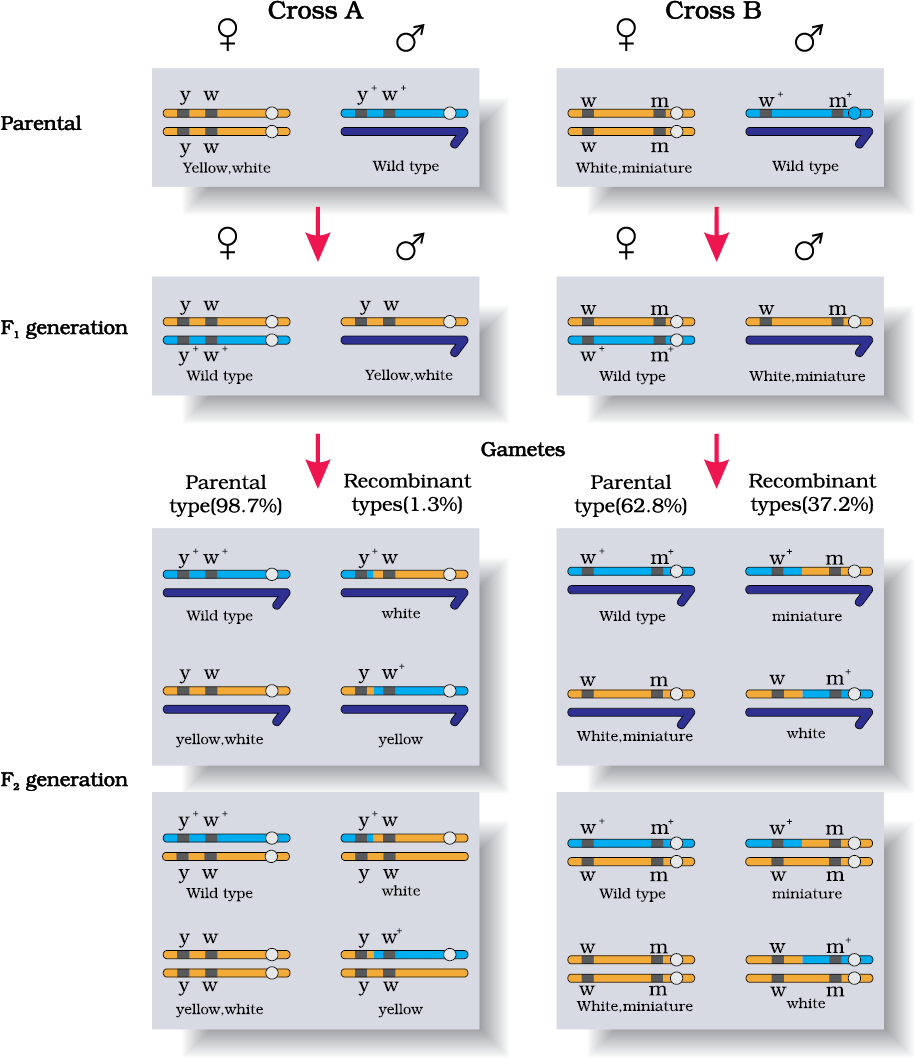
Chromosome
Colored bodies, visualised by staining
Due to advancements in microscopy, scientists were able to carefully observe cell division. This led to the discovery of structures in the nucleus that appeared to double and divide just before each cell division. These were called chromosomes (colored bodies, as they were visualised by staining).
- Chromosome: Structures in the nucleus that appeared to double and divide just before each cell division.
- Year: 1902
Chromosomal Thoery
of Inheritance
The behaviour of chromosomes during meiosis was parallel to the behaviour of genes and chromosome movement can be used to explain Mendel’s laws.
Parallel behaviour..

Chromosomes "...may constitute the physical basis of the Mendelian law of heredity."
Chromosomes as well as genes occur in pairs. The two alleles of a gene pair are located on homologous sites on homologous chromosomes.
Can you tell which of these columns A or B represent the chromosome and which represents the gene? How did you decide?
No, We Can't.
Morgan worked with the tiny fruit flies, Drosophila melanogaster
Experimental verification of the chromosomal theory of inheritance by Thomas Hunt Morgan and his colleagues, led to discovering the basis for the variation that sexual reproduction produced.
Drosophila melanogaster
-
Very suitable for Genetics studies.
They could be grown on simple synthetic medium in the laboratory. They Eat Yeast Present over Banana or Mango
-
Life Cycle of 02 Weeks
They complete their life cycle in about two weeks, and a single mating could produce a large number of progeny flies.
-
It has many types of hereditary variations that can be seen with low power microscopes.
Clear differentiation of the sexes – the male (small) and female (large) flies are easily distinguishable.
-
Summery
- 1. Cinderella of Genetics
- 2. 2n=8 chromosome
- 3. 3 Pairs of Autosome
- 4. XX-XY type of SD
When the two genes in a dihybrid cross were situated on the same chromosome, the proportion of parental gene combinations were much higher than the non-parental type.
T.H. Morgan ATTRIBUTED
-
1.Linkage
The physical association of the two genes on a chromosome -
2.X-Linked Inheritance
in Drosophilla -
3.Recombination
The term used to describe the generation of non-parental gene combinations
Linkage

Complete and Incomplete Linkage
Morgan and his group also found that even when genes were grouped on the same chromosome, some genes were very tightly linked (showed very low recombination) while others were loosely linked (showed higher recombination).

Linkage :
Examples
Morgan found that the genes white and yellow were very tightly linked and showed only 1.3 per cent recombination while white and miniature wing showed 37.2 per cent recombination.
- Note-1:Dominant wild type alleles are represented with (+) sign in superscript
- Note-2:The strength of linkage between y and w is higher than w and m.
Alfred Sturtevant
Student of Morgan, used the frequency of recombination between gene pairs on the same chromosome as a measure of the distance between genes and ‘mapped’ their position on the chromosome.

Today Genetic maps
are extensively used as a starting point in the sequencing of whole genomes as was done in the case of the Human Genome Sequencing.
Chromosomal Theory of..
SEX DETERMINATION
cytological observations made in a number of insects led to the development of the concept of genetic/chromosomal basis of sex-determination
I could trace a specific nuclear structure all through spermatogenesis in a few insects, i observed that 50 per cent of the sperm received this structure after spermatogenesis, whereas the other 50 per cent sperm did not receive it.
Chromosomal theory of SEX Determination
XX-XY
Female-Homogametic, Male - Heterogametic - Found in Humans, Drosophilla and Melandrium
XX-XO
Female-Homogametic, Male - Heterogametic - Found in large number of insects like Grasshoppers
ZW-ZZ
Female-Heterogametic, Male - Homogametic - Found in Birds
Z0-ZZ
Female-Heterogametic, Male - Homogametic - Found in Butterfly and Moth.
Chromosomal Basis
Honey bee

Sex Determination in Honey Bee
is based on the number of sets of chromosomes an individual receives. An offspring formed from the union of a sperm and an egg develops as a female (queen or worker), and an unfertilised egg develops as a male (drone) by means of parthenogenesis.
Haplo-diploidy
In this sex-determination system : Males have half the number of chromosomes(n=16) than that of a female(2n=32). special characteristic feature: Males produce sperms by mitosis.
Drone (Male)
do not have father and thus cannot have sons, but have a grandfather and can have grandsons.

For NEET Biology Download
Our Apps : NEET Quickey and NEET PLay From Google Play.
